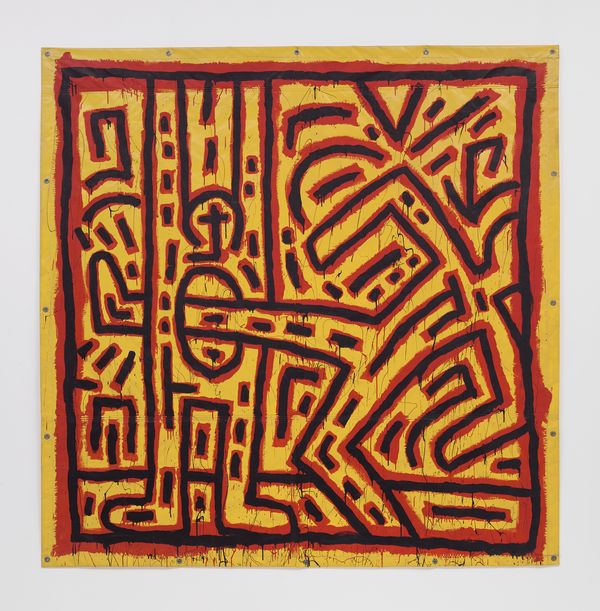Keith Haring Untitled, 1981.
A visceral masterpiece executed at the dawn of Keith Haring’s oeuvre, Untitled, 1981, portrays two human figures mid-movement, outlined in black and red on a yellow background. To the left, a cross-faced man raises his arms far enough to reach the extremity of the vinyl support; next to him, an anonymous counterpart vindictively shoots into the hole that punctures his body, betraying a possibly violent gesture. The work’s dynamism is only emphasized by its all-consuming format, reminiscent of the subway setting from which Haring’s art originated in the late 1970s. Executed at the outset of his fame in the city of New York – which would soon take over the entire world – Untitled was included in the artist’s seminal Tony Shafrazi show in the fall of 1982, and was highlighted in both the artist's watershed retrospective at the Whitney Museum of American Art in 1997, and his first-ever retrospective to focus on the political aspect of his work, held at the Musée d'art moderne de la Ville de Paris, in 2013.
Keith Haring Untitled, 1981.
Recently the subject of important institutional acclaim, Keith Haring’s work has been at the forefront of the public’s attention at a time when the subjects he addressed in his art seem more relevant than ever. His oeuvre was celebrated at Tate Liverpool in 2019 – marking his first major exhibition in the United Kingdom – and is currently at the heart of two simultaneous shows: one at the BOZAR, Brussels, the other at the National Gallery of Victoria, Melbourne. Signifying the ever-intensifying interest vested in his work, growing with time and bleeding beyond borders, Haring will once again be the subject of a solo exhibition at Museum Folkwang, Essen, from May to September 2020.
Parallel to Haring’s sadness, and his social conscience, ran something else: an allegiance to the dance in all its powers of transcendence.
— Robert Farris Thompson
Reflecting the political intentions Haring discreetly weaves into his compositions, the form of a man with a gaping hole in his torso is particularly striking. It forms part of the artist’s cosmos of political signs, first appearing in his work in the early 1980s, following a vision that had occurred to him after the murder of John Lennon. At the time, Haring had recorded the event in his diary and began using it as a pattern within his painterly scenes. Not only does the hole here refer to the murder of a musical legend; it furthermore signifies the sense of emptiness that dawns on the whole of humanity.
Paired with historical context, the image in Untitled assumes increased symbolic meaning. Indeed, the painting was executed in 1981, at the dawn of the AIDS crisis in New York. An unpredictable assault on the body, both absurd and fatal, Untitled shows two viscerally active protagonists visibly consumed by an uncontrollable, intangible energy – allegorical perhaps, of the tragic fatefulness of AIDS, which intruded bodies, unannounced, and ravaged thousands of lives.
Haring’s idiosyncratic dripping aesthetic, in this sense, brings to mind a variety of symbolisms – movement, the melt entailed by fire, and the general collapse of the human body. Yet, on a formal level, it equally recalls the stylistic tendencies that pervaded the art historical canon throughout the 20th century. Notably, a particularity of Untitled is its unequivocal iconographic similitude to Abstract Expressionist canvases. Embodying the painted matter’s irrepressible autonomy, the drips within Untitled more specifically recall the eponymous method carried out by Jackson Pollock. Ceaselessly shifting focus from form and subject matter in his creative process, Haring ultimately marries the two, imparting energetic content with similarly energetic values.
With the present work, one can imagine Haring moving from place to place, waltzing from one quadrant of the vinyl to the other to design his characters in a free-flowing motion. The result is what the viewer sees before his eyes; a dancing scene between two anonymous figures who, despite displaying alarming signs and consequences of violence – a kick, a hole – remain whimsical on the surface. Regarding Haring’s tendency to pair aggression with love, violence with dance, Robert Farris Thompson once noted, ‘Parallel to Haring’s sadness, and his social conscience, ran something else: an allegiance to the dance in all its powers of transcendence’ (Robert Farris Thompson, ‘Notes on the Art and Life of Keith Haring’, 2014). It is perhaps in this sense that Untitled is a chef-d'oeuvre beyond compare; it infiltrates all the masterful elements that have hailed Keith Haring as one of the foremost artists of his time.

